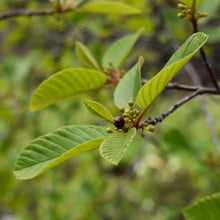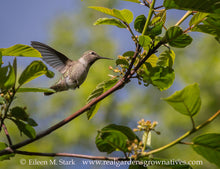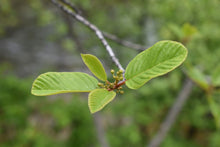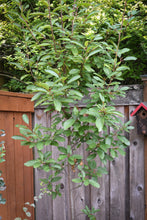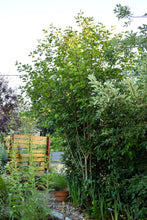
Rhamnus purshiana (formerly/aka Frangula purshiana)
Cascara, also known as Chittum, is an exceptional native yard tree with a small, attractive stature and three-season interest. Its deeply-veined leaves emerge bright green in spring along with clusters of pale greenish-yellow flowers that are adored by hummingbirds and insect pollinators. As the season unfolds, its leaves become more glossy and dark, eventually transforming into a showy display of fall color, especially in sunnier locations, that persists into early winter. Like the leaves, the flowers evolve to fruits as the season progresses, first becoming red berries in summer, then eventually darkening into purplish-black fruits relished by resident and fall migrating birds alike.
- Plant type/canopy layer: deciduous, perennial, small tree
- Size at maturity: 30' tall, 20' wide
- Light requirements: full sun to full shade
- Moisture requirements: moist soil
- Bloom time: April - June
- Growth rate/ease: medium growth rate, easy to grow in the right conditions
- Wildlife support: flowers attract and provide nectar for hummingbirds, adult butterflies, bees and other insect pollinators; fruits are adored by birds such as robins, band-tailed pigeons, grosbeaks, tanangers and especially the pileated woodpecker, while bushtits, kinglets, warblers and chickadees forage on insects found on leaves, twigs and bark; young/new growth is browsed by mule deer and other mammals; overall plant attracts and supports beneficial and pest eating insects and is a caterpillar host plant and larval food source for gray hairstreak and swallowtail butterflies and more than a dozen moth species.
- Native habitat/range: commonly found in a wide range of habitats from riverbanks, dry shady forests, mixed woodlands, moist ravines and floodplains, at low to middle elevations, along the western portion of the Pacific Northwest from British Columbia south into northern California, as well as parts of Idaho and Montana. Portland Plant List - yes.
- Special features & uses: hummingbird favorite; can be used as yellow or green dye; medical, dried bark has been used extensively as a potent laxative, and on sores and swelling. It was first harvested and used sustainability by indigenous people for thousands of years, but post-colonially it has been exploited, over-harvested and commercially sold as Cascara Sagrada (which literally translates, from Spanish as “sacred bark”); landscape uses include erosion control, windbreaks, hederows, pollinator gardens, and woodland gardens.
Gardening with Cascara: Cascara makes an exceptional tree for habitat yards, packing a strong punch in terms of three-season beauty and habitat value into its small statue. Although Cascara can grow in full sun to full shade conditions, it prefers some shade. Most importantly, the more sun it receives, the more you must ensure the soil is moist, well-drained, and contains a fair amount of organic matter (leave the leaves!). Conversely, the more shade it receives, the more drought tolerant it will be. Cascara is fire resistant, but can be sensitive to the poor air quality characteristic of urban environments. So plant it away from busy streets and trucking routes where diesel particulate is highest - and, of course, let’s keep fighting for better air quality for plants, animals and people.
Photo Credits 1, 3, 5: Nikkie West, Sparrowhawk Native Plants
Photo Credit 2: Eileen Stark
Photo Credit 4: Tara Lemezis, Tiny Seed Photography





